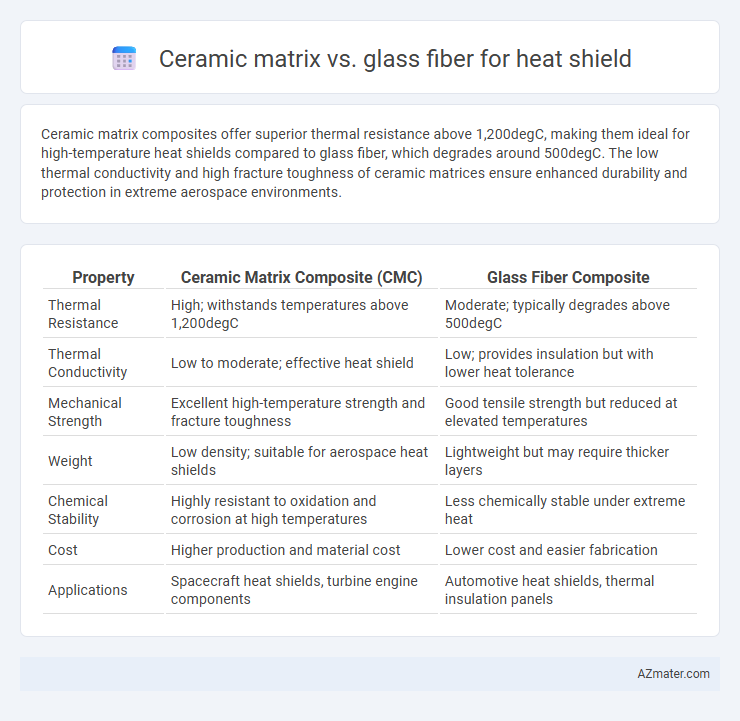Ceramic matrix composites offer superior thermal resistance above 1,200degC, making them ideal for high-temperature heat shields compared to glass fiber, which degrades around 500degC. The low thermal conductivity and high fracture toughness of ceramic matrices ensure enhanced durability and protection in extreme aerospace environments.
Table of Comparison
| Property | Ceramic Matrix Composite (CMC) | Glass Fiber Composite |
|---|---|---|
| Thermal Resistance | High; withstands temperatures above 1,200degC | Moderate; typically degrades above 500degC |
| Thermal Conductivity | Low to moderate; effective heat shield | Low; provides insulation but with lower heat tolerance |
| Mechanical Strength | Excellent high-temperature strength and fracture toughness | Good tensile strength but reduced at elevated temperatures |
| Weight | Low density; suitable for aerospace heat shields | Lightweight but may require thicker layers |
| Chemical Stability | Highly resistant to oxidation and corrosion at high temperatures | Less chemically stable under extreme heat |
| Cost | Higher production and material cost | Lower cost and easier fabrication |
| Applications | Spacecraft heat shields, turbine engine components | Automotive heat shields, thermal insulation panels |
Introduction to Heat Shield Materials
Ceramic matrix composites offer exceptional thermal stability and resistance to oxidation, making them ideal for heat shield applications in high-temperature aerospace environments. Glass fiber materials provide good thermal insulation and structural strength but generally exhibit lower temperature tolerance and durability under extreme heat exposure. Selection between ceramic matrix and glass fiber heat shield materials depends on specific thermal requirements, weight constraints, and operational conditions of the vehicle or device.
Overview of Ceramic Matrix Composites
Ceramic matrix composites (CMCs) consist of ceramic fibers embedded within a ceramic matrix, offering exceptional high-temperature resistance and thermal stability crucial for heat shield applications. Unlike glass fiber composites, CMCs provide significantly enhanced mechanical strength and oxidation resistance at temperatures exceeding 1200degC, making them ideal for aerospace and industrial propulsion systems. Their low density combined with superior fracture toughness contributes to improved durability and weight savings in thermal protection systems.
Essential Properties of Glass Fiber
Glass fiber heat shields excel in thermal insulation, offering high tensile strength and resistance to thermal shock, making them suitable for moderate temperature environments up to approximately 540degC (1000degF). Their lightweight nature and excellent flexibility ensure ease of fabrication and durability under mechanical stress, while maintaining resistance to chemical corrosion and moisture absorption. Unlike ceramic matrix composites, glass fibers provide superior impact resistance and lower cost, though they have lower maximum operating temperatures and slightly reduced thermal stability.
Thermal Resistance Comparison
Ceramic matrix composites exhibit superior thermal resistance compared to glass fiber materials, withstanding temperatures above 1400degC while maintaining structural integrity. Glass fibers generally tolerate maximum temperatures up to 540degC, making them less suitable for extreme heat shield applications. The enhanced thermal stability of ceramic matrices ensures better protection in high-temperature environments such as aerospace and industrial furnaces.
Mechanical Strength and Durability
Ceramic matrix composites exhibit superior mechanical strength and high-temperature durability compared to glass fiber, making them ideal for advanced heat shield applications. Their ability to withstand thermal shock and maintain structural integrity at temperatures exceeding 1200degC surpasses glass fiber, which typically degrades above 600degC. Enhanced fracture toughness and resistance to oxidation ensure ceramic matrices provide long-term performance in extreme heat environments.
Weight Considerations for Aerospace Applications
Ceramic matrix composites offer significantly lower density compared to traditional metal-based heat shields, providing substantial weight savings crucial for aerospace applications where every kilogram impacts fuel efficiency and payload capacity. Glass fiber heat shields, while lightweight and cost-effective, generally have higher density and lower thermal resistance compared to advanced ceramic matrix options, resulting in less optimal weight-to-performance ratios. Prioritizing ceramic matrix materials enhances thermal protection with reduced mass, directly contributing to improved overall aerospace vehicle efficiency and operational range.
Manufacturing Processes and Costs
Ceramic matrix composites (CMCs) require complex manufacturing processes such as chemical vapor infiltration (CVI) or polymer infiltration pyrolysis (PIP), leading to higher production costs compared to glass fiber composites, which are fabricated using simpler methods like resin transfer molding (RTM) or filament winding. The intricate layering and high-temperature treatments necessary for ceramic matrices increase material expenses and labor time, making them less cost-effective for large-scale production. Glass fiber heat shields benefit from faster production cycles and lower raw material costs, making them economically favorable for applications where moderate thermal resistance suffices.
Performance in Extreme Environments
Ceramic matrix composites exhibit superior thermal stability and resistance to oxidation at temperatures exceeding 1,200degC, making them ideal for extreme heat shield applications in aerospace and defense. Glass fiber, while offering good mechanical strength and flexibility, typically degrades above 500degC and lacks the thermal endurance required for ultra-high temperature environments. The enhanced performance of ceramic matrix materials in extreme environments stems from their low thermal conductivity, high melting points, and resistance to thermal shock and chemical corrosion.
Maintenance and Longevity Factors
Ceramic matrix composites exhibit superior heat resistance and durability compared to glass fiber, enabling longer maintenance intervals and enhanced longevity in heat shield applications. Glass fiber materials tend to degrade faster under extreme thermal cycling, resulting in more frequent inspections and replacements. The thermal stability and oxidation resistance of ceramic matrices significantly reduce maintenance demands and extend operational lifespan.
Choosing the Optimal Heat Shield Material
Ceramic matrix composites offer exceptional thermal stability and resistance to extreme temperatures above 1500degC, making them ideal for heat shield applications in aerospace and high-speed vehicles. Glass fiber materials provide good thermal insulation and mechanical strength but typically degrade at lower temperatures around 600-800degC, limiting their effectiveness in ultra-high heat environments. Selecting the optimal heat shield material depends on the required temperature resistance, weight constraints, and mechanical durability, with ceramic matrices preferred for maximum thermal protection and glass fibers chosen for cost-effective, moderate temperature insulation.

Infographic: Ceramic matrix vs Glass fiber for Heat shield
 azmater.com
azmater.com